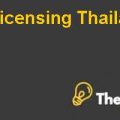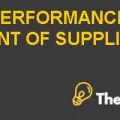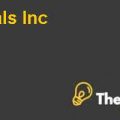Loblaw Companies Limited – Acquiring Shoppers Drug Mart Case Study Solution
Asset Based Valuation
Asset based valuation includes the calculation of TEV on the basis of the fair market value of assets at liquidation. TEV calculated under asset based valuation equals to$6419. It is assumed that the assets would have fair market value at the time of liquidation,which is equal to 2012’s values. However, the TEV computed using the method is not reliable as the method do not consider the expected revenue growth of the company. It does not consider WACC of Loblaw. It also does not consider the future expected cash flows from the acquisition. Therefore, the company should not use asset based valuation method for considering the acquisition price.
Financing Alternatives
After considering DCF as a reliable valuation method, three different financing alternatives can be considered for raising funds for acquisition.
It could be seen that the acquisition price under DCF valuation method is $ 5890 million. The amount could be raised by using one of the following financing alternatives;
- Alternative 1:100% Debt.
- Alternative 2:50% debt and 50% Common Shares.
- Alternative 3:50% Debt, 25% Common Shares and 25% Preferred Shares.
The alternatives are evaluated on the basis of WACC, Tie Ratio, Debt to Equity Ratio and Leverage Ratio.
Table: 2 Summary of Alternatives
| Financing Alternatives and Current Metrics | |||||
| Current | Alternative 1 | Alternative 2 | Alternative 3 | ||
| WACC | 12.2% | 13.67% | 17.84% | 19.48% | |
| TIE Ratio | 3.40 | 1.67 | 2.24 | 2.24 | |
| Debt to Equity Ratio | 0.88 | 1.80 | 0.92 | 0.92 | |
| Leverage Ratio | 0.64 | 0.97 | 0.81 | 0.81 | |
Alternative 1: 100% Debt
The company could finance its acquisition by using 100% debt. However, the alternative has the highest leverage and debt to equity ratio i.e. 0.97 and 1.8 respectively. High debt to equity ratio and leverage ratio increase the default risk of the company.
The investors may get dissatisfied with the increased debt to equity and leverage ratio. Investors may sell the shares of the company, which might lead to declined share price of the company.
Along with the debt to equity and leverage ratio the alternative also has the lowest Tie ratio showing the risk of future incapability of the company to pay interests and taxes.
However, the alternative has the lowest WACC showing a positive point for the alternative. The company would have overall low cost of capital which would increase the returns of the company.
Alternative 2: 50% debt and 50% Common Shares
The company could finance its acquisition by using 50% debt and 50%. The alternative has a leverage and debt to equity ratio i.e. 0.81 and 0.92 respectively. Low debt to equity ratio and leverage ratio lowers the default risk of the company as compared to alternative 1.
However, the alternative has the WACC greater than alternative 1 i.e. 17.84%, showing a negative point for the alternative. The company would have overall high cost of capital as compared to alternative 1, which would decrease the returns of the company.
Alternative 3: 50% Debt, 25% Common Shares and 25% Preferred Shares
Company could finance its acquisition by using 50% debt and 25% common shares and 25% preferred shares. The alternative has a leverage and debt to equity ratio i.e. 0.81 and 0.92 respectively. Low debt to equity ratio and leverage ratio lowers the default risk of the company as compare to alternative 1.
However, the alternative has the highest WACC than both the alternative 1 and 2 i.e. 19.48%, showing a negative point for the alternative. The company would have overall highest cost of capital as compared to alternative 1 and 2, which would decrease the returns of the company drastically.
Recommendation
On the basis of above deep analysis, the company is recommended to use DCF valuation method for evaluating the acquisition price of Shoppers. On the basis of DCF acquisition price various alternatives have been analysed on the basis of WACC, Tie Ratio, Debt to Equity Ratio and Leverage Ratio.
By using the above analysis the company is recommended 2nd financing alternative of 50% debt and 50% common shares. As, the alternative would allow the company to get a reasonable debt to equity position and would maintain the current share prices. The financing alternative has lower WACC than alternative 3, which would resist the decline of returns of the company.
Conclusion
Gina Kolbaneh should consider each valuation method and financing option deeply to effectively evaluate the acquisition of Shoppers and raising funds for the acquisition. Recommended valuation method is DCF, as it is the most reliable method and recommended financing option is 50% debt and 50% common shares. Both the options would lead to an effective and valuable acquisition of Shoppers.
Exhibits
Exhibit A: DCF Valuation
| DCF Valuation | ||||||||
| Actual | Projected over 5 Years | |||||||
| 2011 | 2012 | 2013 | 2014 | 2015 | 2016 | 2017 | ||
| Sales | 10459 | 10782 | $ 11,116 | $ 11,461 | $ 11,816 | $ 12,182 | $ 12,560 | |
| COGS | 6416 | 6609 | 6814 | 7025 | 7243 | 7467 | 7699 | |
| GP | 4042 | 4173 | 4302 | 4436 | 4573 | 4715 | 4861 | |
| Operating Income | 911 | 881 | 908 | 936 | 965 | 995 | 1026 | |
| EBT | 847 | 823 | 849 | 875 | 902 | 930 | 959 | |
| Net Earnings | 614 | 608 | 627 | 646 | 666 | 687 | 708 | |
| Add: Depreciation | 249 | 263 | 271 | 280 | 288 | 297 | 306 | |
| Less: Increase in Working Capital | 5 | 5 | 5 | 5 | 5 | |||
| Less: Capital Expenditures | 390 | 236 | 243 | 251 | 259 | 266.6531 | 274.9193633 | |
| Free Cash Flows | 649.69 | 669.98 | 690.90 | 712.48 | 734.72 | |||
| Terminal Value | 6746.021797 | |||||||
| Time Period | 1 | 2 | 3 | 4 | 5 | |||
| Discount Factor | 0.878336 | 0.771474 | 0.677613 | 0.595172 | 0.522761284 | |||
| Discounted Free Cash Flows | 570.64 | 516.87 | 468.17 | 424.05 | 384.08 | |||
| Discounted Terminal Value | 3526.56 | |||||||
| Net Present Value/ Enterprise Value | $ 5,890.37 | |||||||
Exhibit B: Asset Based Valuation
| Asset Based Valuation | ||
| Total Assets 2012 | $ 17,961 | |
| Less: Total Liabilities | 11542 | |
| Net Worth/ Net Enterprise Value | 6419 | |
| Share Price | $ 31.39 | |
| No. of Outstanding Shares | 204.5 | |
This is just a sample partical work. Please place the order on the website to get your own originally done case solution.







